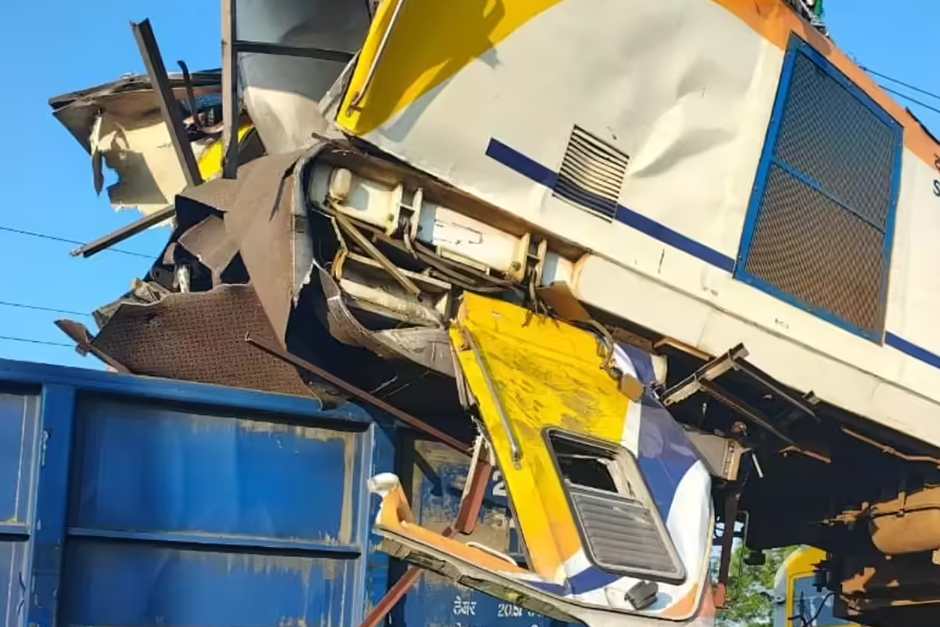A tragic train accident in Chhattisgarh has once again brought railway safety to the forefront of national discourse. An initial probe into the devastating collision has revealed that a passenger train struck a stationary cargo rake following a signal breach, an incident that has tragically claimed at least 11 lives and left dozens injured. The accident, which occurred in the early hours, sent shockwaves across the region, prompting immediate rescue operations and a comprehensive investigation into the precise sequence of events.
The collision involved the Bilaspur-Raigarh MEMU passenger train and a goods train stationed on the same track. Reports indicate that the MEMU train, carrying numerous passengers, overshot a red signal and collided head-on with the freight rake, leading to the derailment of several coaches and severe damage. The force of the impact was immense, trapping many passengers amidst the mangled wreckage and initiating a frantic scramble for survival and rescue.
The Tragic Morning and Immediate Aftermath
The fateful incident unfolded near the Jamgaon station in the Sakti district of Chhattisgarh, a vital corridor for both passenger and freight movement in the region. Local residents were among the first responders, rushing to the scene to assist trapped passengers even before official rescue teams arrived. The initial chaos was compounded by the darkness and the sheer scale of the accident, with cries for help echoing from the twisted metal.
Railway authorities, along with local police and National Disaster Response Force (NDRF) teams, mobilised swiftly. Gas cutters and heavy machinery were deployed to extract victims from the crumpled coaches. Ambulances ferried the injured to nearby hospitals in Raigarh and Sakti, where medical personnel worked tirelessly to provide urgent care. The severity of injuries ranged from minor contusions to critical trauma, necessitating intensive medical attention for many. The rising death toll, confirmed to be 11 as of the latest reports, underscores the brutal impact of the collision and the challenges faced by rescue workers in accessing severely affected compartments.
Indian Railways promptly announced ex-gratia payments for the victims: ₹5 lakh for the kin of the deceased, ₹1 lakh for those with grievous injuries, and ₹25,000 for those with minor injuries. This immediate relief measure aims to provide some support to the affected families grappling with the profound loss and medical expenses.
Initial Probe Points to Signal Breach
The preliminary findings of the investigation have homed in on a critical failure: a signal breach. This refers to a situation where a train driver passes a ‘stop’ signal, proceeding onto a track section that is not cleared for their movement. In this instance, it appears the passenger train entered a block section where the cargo rake was already positioned, leading directly to the collision.
While a detailed inquiry is still underway to ascertain all contributing factors, the focus on a signal breach highlights potential lapses, either human error, technical malfunction, or a combination thereof. Railway safety protocols are stringent, designed to prevent such occurrences through interlocking systems and automated warnings. The Commissioner of Railway Safety (CRS), an independent body, has been tasked with conducting a thorough probe into the incident, examining everything from track conditions and signalling systems to the training and alertness of the operating crew.
A senior railway official, speaking on condition of anonymity due to the ongoing investigation, stated, “Our initial assessment strongly indicates a signal breach. We are meticulously examining the data loggers, Loco Pilots’ statements, and the functioning of the interlocking system to determine exactly why the train overshot the red signal. Accountability will be fixed once the full picture emerges.” This statement underscores the gravity with which the Indian Railways approaches such incidents and its commitment to uncovering the truth.
Towards Accountability and Future Prevention
The Chhattisgarh train accident is a stark reminder of the complexities inherent in operating one of the world’s largest railway networks. While Indian Railways has made significant strides in modernising its infrastructure and enhancing safety measures, incidents like this underscore the constant need for vigilance and continuous improvement.
The ongoing inquiry will delve into various aspects, including the possibility of human error on the part of the loco pilot or assistant loco pilot, any technical glitches in the signalling system, and adherence to standard operating procedures. Lessons learned from this tragedy will be crucial for implementing further preventative measures. Such incidents often lead to reviews of safety protocols, enhanced training for railway staff, and potential upgrades to signalling and train control technologies across the network, such as the indigenous Kavach system designed to prevent collisions.
As the nation mourns the loss of lives and prays for the speedy recovery of the injured, the imperative for robust railway safety remains paramount. The outcome of the full investigation will not only provide answers to the grieving families but also guide future strategies to ensure that such a devastating signal breach does not recur, safeguarding the millions who rely on Indian Railways daily.
Stay tuned to TrendLyric.com for further updates on this developing story.




